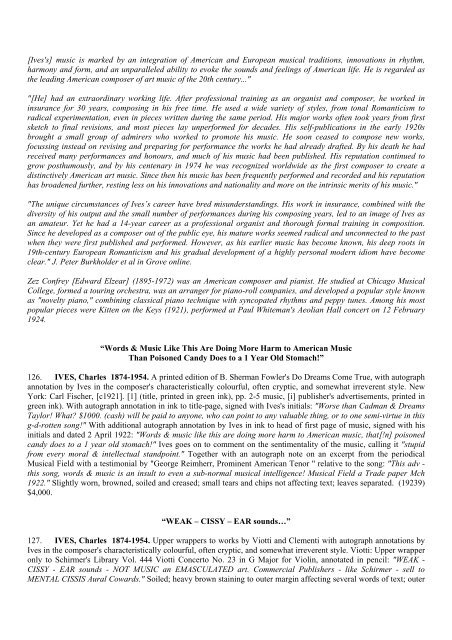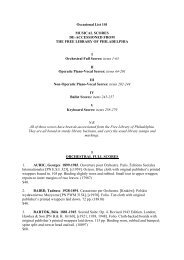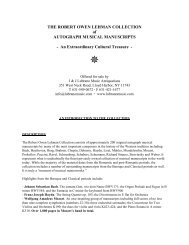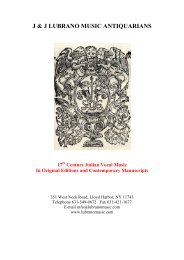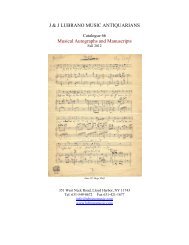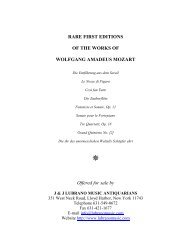Catalogue 63 - J & J Lubrano, Music Antiquarians
Catalogue 63 - J & J Lubrano, Music Antiquarians
Catalogue 63 - J & J Lubrano, Music Antiquarians
You also want an ePaper? Increase the reach of your titles
YUMPU automatically turns print PDFs into web optimized ePapers that Google loves.
[Ives's] music is marked by an integration of American and European musical traditions, innovations in rhythm,<br />
harmony and form, and an unparalleled ability to evoke the sounds and feelings of American life. He is regarded as<br />
the leading American composer of art music of the 20th century..."<br />
"[He] had an extraordinary working life. After professional training as an organist and composer, he worked in<br />
insurance for 30 years, composing in his free time. He used a wide variety of styles, from tonal Romanticism to<br />
radical experimentation, even in pieces written during the same period. His major works often took years from first<br />
sketch to final revisions, and most pieces lay unperformed for decades. His self-publications in the early 1920s<br />
brought a small group of admirers who worked to promote his music. He soon ceased to compose new works,<br />
focussing instead on revising and preparing for performance the works he had already drafted. By his death he had<br />
received many performances and honours, and much of his music had been published. His reputation continued to<br />
grow posthumously, and by his centenary in 1974 he was recognized worldwide as the first composer to create a<br />
distinctively American art music. Since then his music has been frequently performed and recorded and his reputation<br />
has broadened further, resting less on his innovations and nationality and more on the intrinsic merits of his music."<br />
"The unique circumstances of Ives’s career have bred misunderstandings. His work in insurance, combined with the<br />
diversity of his output and the small number of performances during his composing years, led to an image of Ives as<br />
an amateur. Yet he had a 14-year career as a professional organist and thorough formal training in composition.<br />
Since he developed as a composer out of the public eye, his mature works seemed radical and unconnected to the past<br />
when they were first published and performed. However, as his earlier music has become known, his deep roots in<br />
19th-century European Romanticism and his gradual development of a highly personal modern idiom have become<br />
clear." J. Peter Burkholder et al in Grove online.<br />
Zez Confrey [Edward Elzear] (1895-1972) was an American composer and pianist. He studied at Chicago <strong>Music</strong>al<br />
College, formed a touring orchestra, was an arranger for piano-roll companies, and developed a popular style known<br />
as "novelty piano," combining classical piano technique with syncopated rhythms and peppy tunes. Among his most<br />
popular pieces were Kitten on the Keys (1921), performed at Paul Whiteman's Aeolian Hall concert on 12 February<br />
1924.<br />
“Words & <strong>Music</strong> Like This Are Doing More Harm to American <strong>Music</strong><br />
Than Poisoned Candy Does to a 1 Year Old Stomach!”<br />
126. IVES, Charles 1874-1954. A printed edition of B. Sherman Fowler's Do Dreams Come True, with autograph<br />
annotation by Ives in the composer's characteristically colourful, often cryptic, and somewhat irreverent style. New<br />
York: Carl Fischer, [c1921]. [1] (title, printed in green ink), pp. 2-5 music, [i] publisher's advertisements, printed in<br />
green ink). With autograph annotation in ink to title-page, signed with Ives's initials: "Worse than Cadman & Dreams<br />
Taylor! What? $1000. (cash) will be paid to anyone, who can point to any valuable thing, or to one semi-virtue in this<br />
g-d-rotten song!" With additional autograph annotation by Ives in ink to head of first page of music, signed with his<br />
initials and dated 2 April 1922: "Words & music like this are doing more harm to American music, that[!n] poisoned<br />
candy does to a 1 year old stomach!" Ives goes on to comment on the sentimentality of the music, calling it "stupid<br />
from every moral & intellectual standpoint." Together with an autograph note on an excerpt from the periodical<br />
<strong>Music</strong>al Field with a testimonial by "George Reimherr, Prominent American Tenor " relative to the song: "This adv -<br />
this song, words & music is an insult to even a sub-normal musical intelligence! <strong>Music</strong>al Field a Trade paper Mch<br />
1922." Slightly worn, browned, soiled and creased; small tears and chips not affecting text; leaves separated. (19239)<br />
$4,000.<br />
“WEAK – CISSY – EAR sounds…”<br />
127. IVES, Charles 1874-1954. Upper wrappers to works by Viotti and Clementi with autograph annotations by<br />
Ives in the composer's characteristically colourful, often cryptic, and somewhat irreverent style. Viotti: Upper wrapper<br />
only to Schirmer's Library Vol. 444 Viotti Concerto No. 23 in G Major for Violin, annotated in pencil: "WEAK -<br />
CISSY - EAR sounds - NOT MUSIC an EMASCULATED art. Commercial Publishers - like Schirmer - sell to<br />
MENTAL CISSIS Aural Cowards." Soiled; heavy brown staining to outer margin affecting several words of text; outer


